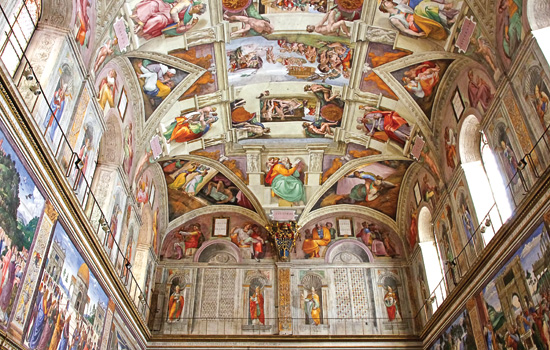Controlling the air inside a masterpiece
Jackie Russo Anderson ’07 was part of a team that improved the air quality system at the Sistine Chapel.
Michelangelo was 33 when he began painting scenes from Genesis and the familiar hands of God and Adam on the ceiling of the Sistine Chapel—masterpieces considered the work of a lifetime.
Jackie Russo Anderson ’07 (mechanical engineering) was just 30 when she was involved as part of an international engineering team that designed an ultramodern air management system to preserve the chapel’s historic artwork, without changing any part of the building’s original structure.
“I would never have thought during my time at RIT, that at 30 years old, I’d be working on a project at the Sistine Chapel. That’s something that normally happens down the road, in your life, in your career,” said Anderson, who is a senior engineer in air management systems technology at Carrier, a division of UTC Building & Industrial Systems, the company that led the project.
More than 6 million people a year take in the majestic beauty of the chapel’s frescoes on its walls and alcoves, under vaulted arches and on the ceiling. But the 500-year-old chapel in Vatican City was showing signs of wear due to the dust and debris brought in by tourists often exceeding capacity.
Anderson worked with an international team of engineers from Carrier’s offices in Syracuse, France and China, as well as art and communications representatives from the Vatican and the Italian Consulate involved in the chapel preservation efforts, which began in 2011 and were completed this past October. The previous air ventilation system was also being taxed, as it was designed to accommodate a maximum load of 700 simultaneous visitors. Today, the new system is designed to accommodate up to 2,000 visitors at one time.
While an undergraduate at RIT, Anderson studied airflow and contamination and was part of Professor Risa Robinson’s mechanical engineering team studying cigarette smoke particle deposition in the lungs. This became the basis for her master’s thesis. She refined this further as a doctoral student at Syracuse University, focusing on indoor air quality. Hired by Carrier in 2011, Anderson uses all these accumulated skills working on new technology development, fan design and system and custom applications for the company.
“The work I did with Dr. Robinson easily transferred to the indoor air quality work that I studied for my Ph.D., which provided for an easy transition to the air management team at Carrier,” she said. “The Sistine Chapel project was both an air management and an indoor air quality challenge. The scale is very different between a human lung and the Sistine Chapel, but the underlying physics were solved with the same methods.”
The team had some modeling limitations when it came to the building. It was a bigger scale than what they were used to, and they couldn’t change anything in the structure.
“The Sistine Chapel is just an enormous building, and then you have these huge, really thick stone walls on the exterior which are hundreds of years old,” she explained.
To prepare, Anderson and her colleagues studied the HVAC system, put in place by Carrier 20 years ago. It was still fully functional, but the air system capacity needed to increase. The chapel did not have the ductwork or internal ventilation structures that modern homes and buildings do today. Temperatures needed to be controlled for the sake of the paintings and the people, but bringing in more air meant larger vent openings, and this was not an option.
Anderson did not visit the Sistine Chapel until after her preliminary design and modeling work was complete in May 2014.
“I had spent a lot of time modeling the interior of the Sistine Chapel, so I was very familiar with the overall dimensions of the space,” she said. “But when I first walked in I couldn’t believe how big it actually was and how amazing the paintings were. Michelangelo was a true genius.”
It is ironic that Michelangelo’s impressive masterpiece on the ceiling of the Sistine Chapel illustrating the creation of humanity was being damaged by the crowds of modern humanity that visit the chapel each year.
“My role related to the air management within the chapel and how we would deliver three times more airflow without increased velocities near any of the paintings and without any structural changes to the chapel itself,” Anderson explained. “There were also aspects of controlling carbon dioxide and other contaminants that I modeled with computational fluid dynamic tools. One of the major portions of the project that I worked on was the design, modeling and testing of the diffuser that now delivers the conditioned air to the space.”
The team successfully increased the volume of air within the chapel through the complex diffuser system, vented through several small openings under the windows in the chapel, all part of the original ventilation system. It was also able to dilute carbon dioxide produced by visitors. The new diffuser Anderson produced could only have been achieved with an understanding of airflow and how to manipulate the physics of increasing the airflow through small, unyielding spaces.
Anderson returned to the Vatican for the system unveiling after installation was complete in October 2014.
“When I first started working on this, I didn’t necessarily understand how amazing the project really was until it started to come together,” she said. “Now, seeing how many people care about it, how much the Vatican has appreciated it, you really understand how special a project this was to be a part of.”
 The Sistine Chapel, one of the most visited historical sites at the Vatican, was showing signs of wear due to the volume of visitor traffic, and its air ventilation system was being taxed. Today, with a new system it can accommodate up to 2,000 visitors at one time in nearly any weather conditions.
The Sistine Chapel, one of the most visited historical sites at the Vatican, was showing signs of wear due to the volume of visitor traffic, and its air ventilation system was being taxed. Today, with a new system it can accommodate up to 2,000 visitors at one time in nearly any weather conditions.







